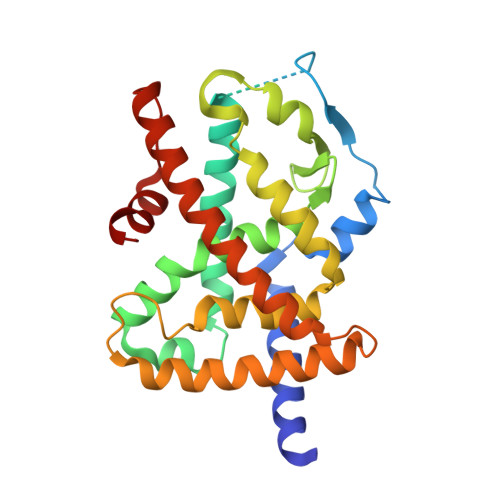The differential interactions of peroxisome proliferator-activated receptor gamma ligands with Tyr473 is a physical basis for their unique biological activities.
Einstein, M., Akiyama, T.E., Castriota, G.A., Wang, C.F., McKeever, B., Mosley, R.T., Becker, J.W., Moller, D.E., Meinke, P.T., Wood, H.B., Berger, J.P.(2008) Mol Pharmacol 73: 62-74
- PubMed: 17940191
- DOI: https://doi.org/10.1124/mol.107.041202
- Primary Citation of Related Structures:
2P4Y - PubMed Abstract:
Despite their proven antidiabetic efficacy, widespread use of peroxisome proliferator-activated receptor (PPAR)gamma agonists has been limited by adverse cardiovascular effects. To overcome this shortcoming, selective PPARgamma modulators (SPPARgammaMs) have been identified that have antidiabetic efficacy comparable with full agonists with improved tolerability in preclinical species. The results of structural studies support the proposition that SPPARgammaMs interact with PPARgamma differently from full agonists, thereby providing a physical basis for their novel activities. Herein, we describe a novel PPARgamma ligand, SPPARgammaM2. This compound was a partial agonist in a cell-based transcriptional activity assay, with diminished adipogenic activity and an attenuated gene signature in cultured human adipocytes. X-ray cocrystallography studies demonstrated that, unlike rosiglitazone, SPPARgammaM2 did not interact with the Tyr473 residue located within helix 12 of the ligand binding domain (LBD). Instead, SPPARgammaM2 was found to bind to and activate human PPARgamma in which the Tyr473 residue had been mutated to alanine (hPPARgammaY473A), with potencies similar to those observed with the wild-type receptor (hPPARgammaWT). In additional studies, we found that the intrinsic binding and functional potencies of structurally distinct SPPARgammaMs were not diminished by the Y473A mutation, whereas those of various thiazolidinedione (TZD) and non-TZD PPARgamma full agonists were reduced in a correlative manner. These results directly demonstrate the important role of Tyr473 in mediating the interaction of full agonists but not SPPARgammaMs with the PPARgamma LBD, thereby providing a precise molecular determinant for their differing pharmacologies.
Organizational Affiliation:
Department of Metabolic Disorders, Merck Research Laboratories, 126 E. Lincoln Ave., Rahway, NJ 07065, USA.
















